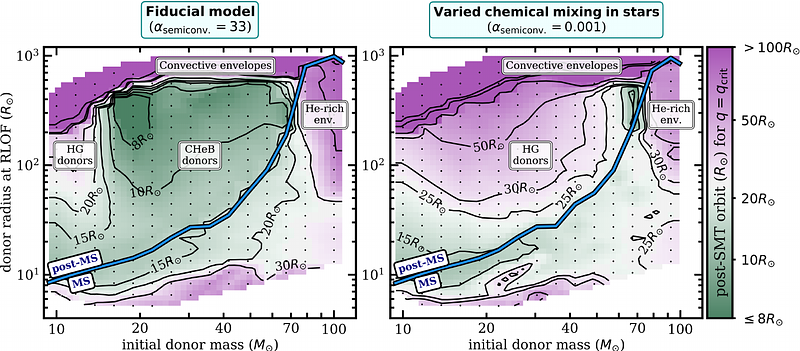A fundamental limit to how close binary systems can get via stable mass transfer shapes the properties of binary black hole mergers

A fundamental limit to how close binary systems can get via stable mass transfer shapes the properties of binary black hole mergers
Jakub Klencki, Philipp Podsiadlowski, Norbert Langer, Aleksandra Olejak, Stephen Justham, Alejandro Vigna-Gómez, Selma E. de Mink
AbstractMass transfer in binary systems is the key process in the formation of various classes of objects, including merging binary black holes (BBHs) and neutron stars. Orbital evolution during mass transfer depends on how much mass is accreted and how much angular momentum is lost $-$ two of the main uncertainties in binary evolution. Here, we demonstrate that there is a fundamental limit to how close binary systems can get via stable mass transfer (SMT), that is robust against uncertainties in orbital evolution. Based on detailed evolutionary models of interacting systems with a BH accretor and a massive star companion, we show that the post-interaction orbit is always wider than $\sim10R_{\odot}$, even when extreme shrinkage due to L2 outflows is assumed. Systems evolving towards tighter orbits become dynamically unstable and result in stellar mergers. This separation limit has direct implications for the properties of BBH mergers: long delay times ($\gtrsim1 \rm Gyr$), and no high BH spins from the tidal spin-up of helium stars. At high metallicity, the SMT channel may be severely quenched due to Wolf-Rayet winds. The reason for the separation limit lies in the stellar structure, not in binary physics. If the orbit gets too narrow during mass transfer, a dynamical instability is triggered by a rapid expansion of the remaining donor envelope due to its near-flat entropy profile. The closest separations can be achieved from core-He burning ($\sim8-15R_{\odot}$) and Main Sequence donors ($\sim15-30R_{\odot}$), while Hertzsprung Gap donors lead to wider orbits ($\gtrsim30-50R_{\odot}$) and non-merging BBHs. These outcomes and mass transfer stability are determined by the entropy structures, which are governed by internal composition profiles. The formation of compact binaries is thus sensitive to chemical mixing in stars and may relate to the blue-supergiant problem.